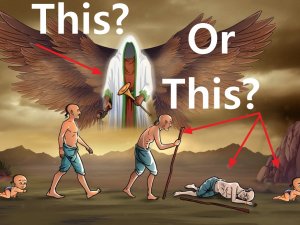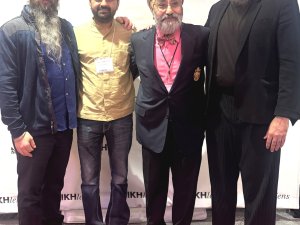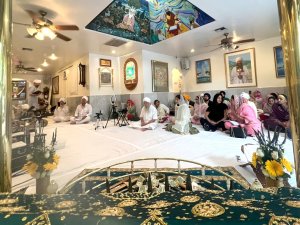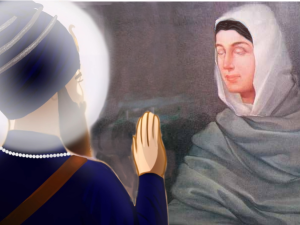Recently SikhNet sat down with Eileen Alden. She is one of the creative forces behind the new SUPER SIKH COMIC.
Click here to read Part one of this exclusive interview...
How long did you study Gurmukhi for?
Well I started about a year ago. It took my a few months to learn Gurmukhi. You know I had learned Japanese, so I wasn’t afraid of the Gurmukhi characters, there’s only 35. I just kind of jumped in. And I’m not perfect at it at all. I have trouble with various ‘D’ sound pronunciations and that will continue to be a challenge. What’s more important is what I believe is happening and I’ve thought about this because I’ve been asked this a lot; In the process of translating, in my mind, it was forcing me to make these connections, “What does this really mean?” Even at the very beginning, “What does it mean if you say that ‘The Creator is Truth’? The word for the Creator, the name, the rule for the Creator is Truth, what does that actually mean? Forget just the definitional question, if you’re trying to think about how would you say that in your own words, in your own experiences. It was that process of trying to understand where these ideas came up for me because I had to make it more personal.
For
example, what does ‘houmai’ mean? What does ‘ego’ mean? Is it
just vanity or is there something else? What does it mean to be
selfless and when am I most selfless? What is the context here that
we are talking about? It was the veechaar, the getting to an
understanding that opened up my mind. I’ve had such profound
revelations from that; It’s really life changing. It’s not so
much about “Do you know Gurmukhi or not?” I do Gurbani veechaar
sessions with friends and I prepare with a bunch of dictionaries and
I go word by word and I try to think about each pourhi as we’re
going through. It’s a process, it’s not like I have this fluency
or something. I think it was just taking the time with the words and
concepts that it triggers things in my mind on a very deep level. It
says it right there in the text, if you turn to face these words of
the Guru, as Gurmukh you become connected with the creator.
It’s funny because I could read this at arms length, “Oh, sure, blah, blah, blah, turn your face to understand and contemplate the bani.” But, no, actually if you do it, it seems to happen, haha. Even though it says it repeatedly in the text, right. I wouldn’t have believed it if it hadn’t affected me that way. I wouldn’t have just accepted that.
You said that you were agnostic before and your mind started to be opened up. Opened up to what?
Yeah, I was, full disclosure here: I was beyond agnostic because I was a
philosophy major in college. I studied metaphysics and epistemology.
So I was doing probabilistic proofs for the existence of God. You
know logic was my thing. Analytics, that’s where I go for proof.
What happened was as I read and contemplated the text, I started to
question my own ideas about things and I let these ideas in. For
example, “Is there a Creator or not?” You can answer that
question from a logical standpoint, you can rationalize it logically
in your analytical brain, or you can look for evidence in the world
and look for a scientific approach, or there was this third way that
I had never thought about before that the Gurbani just tapped me
into. It was, “What do you understand intuitively to be true. If
you could connect to that anahad shabd, what is that telling you?
When I was forced to try and understand and think about that I went,
“Oh my god, I believe this to be true!”
I believe in, what I had been calling a secular humanism, the value of life and of all people. Now I thought, “What a second, this is beyond that, this is real truth, it’s Sat Nam, it’s actually real.” I just really changed my perspective on things to think about it that way. Everything leads to something else in the Bani, it was a journey. I think what’s fascinating to me, even though those were the initial flashes of understanding and awareness, it continues to happen. That’s why I’m so in love with the Guru and ongoing study of Gurbani, because it continues to floor me. I was talking with one of my friends who was asking me, “Why do you spend so much time immersed in this? Why are you immersing yourself in this culture and this language and this translating?” And I said, “Well think of it this way: If you told a regular secular American that the way to 100 million dollars was in this text, everyone would know Gurmukhi. People would be reading it as they commute to work, there would be blogs about it, online chats. People would be trying desperately to find this 100 million dollars. Even if it was written in ancient hieroglyphics, people would follow and pursue. But if instead you say, “No, it’s actually the meaning of life, that’s what’s in the text.” Than people would say, “Well, no, actually I’m busy. I’ve got stuff to do, I really don’t have time.” So what do you value?
If you had the glimpse in, how far would you go? How could you stop?
You seem like a very active person who has a strong passion and interest in different subjects. This sounds like a different kind of spark though…
Absolutely, It’s very different, it’s very different. These things that I’ve done creatively, they’re certainly part of who I am, that’s undeniable. As I look back I’ve always looked for these creative outlets. I’ve just never before found something that, like you said a passion, that goes above and beyond. It’s not just what I do, it is what I do and I do it for a purpose. It’s purposeful. Even just the idea of creating. Creating for what? For personal fulfillment, is it a self help thing? No, what if it actually has meaning in the world and it can actually make a difference?
One of my biggest take-aways that’s affected me from Gurbani is a call to action. I felt really drawn to act. I don’t know where else it could have come from because I haven’t felt this drawn to act before in my life. I’ve always been a progressive thinker and I’ve always had an activist kind of perspective on things but I think this is the most active I’ve ever personally felt, I feel a personal responsibility now that is very powerful.
What acts are you drawn to do? You feel a personal responsibility for what?
For the actions in my life to make it different. I’m really looking at my life to be more purposeful. I feel supported by that. It’s opened this awareness for me that says, “You know what there’s this other purposefulness that needs to be tapped into." if I can listen to it. If I can listen to that Creator within and listen to that conscience where the Creator speaks to me and just continue to do the right thing, it’s a very powerful motivator for me.
So the comics have taken on a whole life of their own. We are really doing these comics! It’s not just, “Yeah maybe we’ll do a comic, maybe not…” No, we are doing this comic no questions. No matter what, it’s happening.
I
think catchphrase is so fresh and snappy.
"Loves Elvis. Hates bad guys".
It’s funny because when we think about these characters and when I was thinking about the traditional superhero archetype, they all have this issue with not enough diversity in comics. It made me think that every hero has a back story. Whether it’s the superman origin story or whatever the origin story is, everyone comes from somewhere. So it was interesting for me to play on the idea of mixing the east and the west that are present in our modern world. People have not been immunized from ideas that have reached around the globe, and because of that, people have different quirks. I think it’s somehow important to say “look this is a real human guy. He’s quirky. He’s not perfect as one might envision some artificial character. He’s got a sense of humor. He sometimes likes quips and one liners." We came at it from the lens of someone you could see yourself in. I personally am quirky, I think everyone has their own quirks, things that they like that other people don’t like and other people love. So I was trying to express that he’s an individual. An individual who is making use of his talents.
I think young people will appreciate how this character seems more attainable that perhaps some other super heroes or even characters in history.
I’d like to mention something on that point because I think that’s really important. As I was doing my research I looked for Sikh fiction and I couldn’t find it. That was very disturbing to me. I think it’s very important. It’s another angle for discussion, dialogue, ideas to flow and imagination. It doesn’t matter if you're imagining a world a hundred years in the future or another take on today's world. Think about what our kids do at school, they read these “approved” stories and they have critiques and analysis. What’s being said in 'Lord of the Flies'? What is Shakespeare's purpose here? This dialogue and literary critique is very healthy. If you think of it that way, this could be one story of many, whether it’s comics or graphic novels, or traditional fiction, whatever the case may be, just use it as a starting point. Let’s talk about what it means to be modern yet live with traditional values. What’s that like?
I recently saw the film Shah Faqir at the Sikh Lens Film Festival. That was a perfect example of imagining these historical events. You’re going to fill in blanks between conversations that might have happened. I think we just need to build on that approach and bring things into modern times. It’s risky. There’s risk involved because I’m not perfect, the characters are not perfect and the story’s not perfect, and never will be. But, like all art, you put it out there and then you let it go for people to embrace or reject or discuss. I think more is better. When you have more variety of stories, different types of characters who approach things differently, than the weight is not all on one story or one film to tell everything. No, just bring out more stories.
The kickstarter goal has already been reached yet there is still money being donated. Please explain.
When
we started out I didn’t know if we were going to get $20 or if we
would reach the full $5,000. I’ve never done a kickstarter before.
We tried it out and set out to do issue # 1 as our goal. We felt that
if we could do issue 1, even if it took us to the end of the month
down to the wire, then we could publish it, distribute it and we
could gain the interest for the next three issues. Since we raised
the $5,000 so quickly, we want to explain to people that there is a
higher goal all the way up to $20,000 which would cover all the first
four issues. If that happens it would be phenomenal because we can
just go uninterrupted producing and getting these out there. If that
happened our process would not be delayed with more fund raising.
We had no idea what kind of support we’d get. We are scrambling a little bit now to keep up. Issue one is guaranteed, we’re coloring some pages right now, we’re in full production mode through the end of the month on issue # 1. It’s incredible.
I’d like to order one!
Absolutely! That’s the beauty of kickstarter, even though we’ve reached the goal, you can still order the comic. We can make as many comics as are ordered. We make comics in batches of 1,000 whenever we hit the $5,000 mark. Or you can order all 4 issues in advance and they’ll just come in the mail as we produce them. It’s like pre-ordering. That’s why the kickstarter is still going on until we reach enough to fund for all four issues. If we all those four ($20,000) then it will go to the next story and start to fund those. We’re taking no profit, we’re just covering the cost of the venture.
I have one last question. You have talked about how Gurbani has affected your mind. How has your increased knowledge of Gurbani and Punjabi culture affected the script?
That’s a really interesting question. I think I was able to understand our heroes perspective a lot better. As we start to go into his crisis mode, in particular, I understood better where he would find his strength and how he would find his strength. I don’t want to give away too much of the story but I think it mostly helped me to think about him trying to solve problems that he was facing. There’s a lot of insight there. I’ll just leave it at that and you can see how it unfolds.
There is one other thing I would like to highlight because I think it’s relevant particularly to people in the west in looking at this. My initial research was answering some of the immediate questions around the five k’s and Sikh history and so forth to structure the story. But when you think about the Gurbani perspective you really get away from the traditional way of thinking. I had to look at it deeper and say, “Ok we may have been able to get the form right, which I could see from my initial research, but now I get to see the substance underneath the form." That I think is really important to get across in the story itself. This is not just about a hero who has a turban, it’s also about what it means. What does it mean for him to be that person and trying to live those values. That has come through a lot more strongly.
Thank you for sharing your time with us. I think people are going to appreciate your story.
Oh that’s so great! Awesome!





